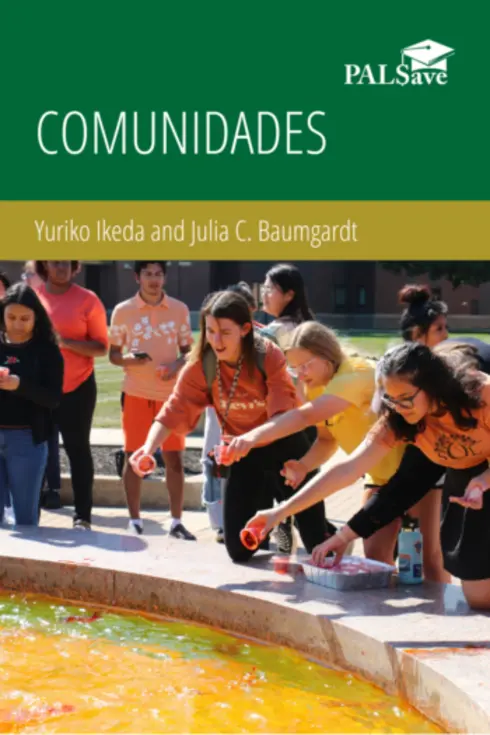
Comunidades
![]()
![]()
![]()
![]()
![]()
Yuriko Ikeda, Marian University
Julia Baumgardt, Marian University
Copyright Year:
ISBN 13: 9781956390216
Publisher: PALNI
Language: English
Formats Available
Conditions of Use
![]() Attribution
Attribution
CC BY
Reviews
Reviewed by Farah Ali, Assistant Professor of Hispanic Studies, DePauw University on 9/4/24
As a first semester textbook, the content included is fairly comprehensive, and includes a wide range of topics with regard to vocabulary, grammar, and cultural knowledge, all of which are appropriate to complete beginners in Spanish. Topics are... read more
![]()
![]()
![]()
![]()
![]()
Reviewed by Farah Ali, Assistant Professor of Hispanic Studies, DePauw University on 9/4/24
Comprehensiveness
As a first semester textbook, the content included is fairly comprehensive, and includes a wide range of topics with regard to vocabulary, grammar, and cultural knowledge, all of which are appropriate to complete beginners in Spanish. Topics are focused on personal experiences of students: e.g. being able to talk about one's self, as well as one's friends, family, and communities. There is no index or glossary included, but I do not see this as a major shortcoming for my teaching purposes.
Content Accuracy
The textbook content is accurate, and I have not come across and errors. One subtle bias that does come across is that towards peninsular Spanish. While this is certainly the standard in Spanish textbooks, I would have liked to have seen this de-centered. There are some efforts to highlight linguistic diversity throughout the textbook: for example, the usage of 'vos' is included. However, it's only mentioned, but not included in verb conjugation charts, while another dialectal variant - 'vosotros' - is consistently there. I would have liked to have seen 'vos' included in these verb conjugation charts.
Relevance/Longevity
The content is up-to-date, and I would feel comfortable using this textbook for a long time before it requires updating. I think an easy way of updating some of the content when necessary is to focus on some of the cultural components (like including newer videos or readings and accompanying activities).
Clarity
Content is completely accessible and all material is explained clearly to students. Both Spanish and English language text are adequately contextualized.
Consistency
Content is generally consistent, including the use of terminology and authors' framework for presenting content. From chapter to chapter, this book reads very cohesively. However, as noted previously, 'vos' is mentioned as a pronoun that's used in Latin America, but it's never included in the formal grammatical construction. I think including 'vos' would have lent further consistency. Not only that, but I think having that consistent inclusion would help legitimize its usage and push back against the accepted practice of centering peninsular Spanish.
Modularity
The textbook uses the same structure for each chapter, making it easy to divide into teachable chunks. These sections include: Tira cómica (vocabulary and structures in context); ¿Te fijaste que…? (initial exploration of cultural practices and perspectives in the Spanish-speaking world); Ampliación (takes a deeper dive into cultural products and practices in the Spanish-speaking world); Vocabulario (key lesson vocabulary); Video entrevistas (Puts vocabulary and structures in context); Gramática (Explains target structures). Within each of these sections, texts were generally concise and avoided large, overwhelming blocks of text.
Organization/Structure/Flow
The book is organized and material is mostly presented in a logical fashion. One item that I was surprised to encounter in a first semester book was a partial presentation of commands - specifically tu and vosotros. While commands are often taught in chunks (e.g. teaching formal commands separately, and also linking formal commands and negative informal commands to the presentation of the present subjunctive), they're all usually taught in the same semester so students can make links between these different types of forms: distinguishing formal and informal commands (in their affirmative and negative forms), but then also recognizing some of these forms in the subjunctive. I also offer this comment recognizing that some students may find it overwhelming to learn such similar forms in the same semester, which may have been the intention behind introducing commands here. Apart from the presentation of commands, the topics included in this textbook generally follow a logical order that is level-appropriate for first-semester Spanish students.
Interface
There are no interface issues, and navigating the textbook is relatively easy. One area of improvement here though is that - because each chapter is quite long - it would be easier if there were clickable links to reach specific sections of the textbooks, not just the beginning of each chapter. This, however, is simply a convenience issue. I have not encountered any major problems in accessing any of the content or navigating from one part to the next.
Grammatical Errors
I did not come across any grammatical errors, neither in Spanish nor in English. The text seems to have been thoroughly proofread.
Cultural Relevance
I appreciate the consistent attention to culture throughout this text, as well as the specific topics of choice. However, I would have liked to have seen more diverse racial representation throughout this text. Indigenous and especially Afrolatinx identities are virtually invisible in Spanish textbooks and that is somewhat the case here.
Commentsno
Table of Contents
- Publisher's Note
- Instructor Guide
- Student Guide
- ¡Soy yo!
- Mis amistades
- Mi familia
- Mi comunidad
- Mi universidad
- Contributors
About the Book
This is a textbook for first-semester Spanish with a focus on the cultural products, practices and perspectives of Spanish-speaking communities in the world today. This text is designed to build students’ cultural and communicative proficiency at the novice level through interaction with authentic resources and real-life video conversations featuring native Spanish speakers living in the American Midwest. Each chapter includes interactive activities focused on each of the three modes of communication (interpretive, interpersonal and presentational), at least one Integrated Performance Assessment, exercises with automated feedback and prompts that promote cross-cultural comparisons through research and reflection.
About the Contributors
Authors
Yuriko Ikeda, Marian University
Julia Baumgardt, Marian University
